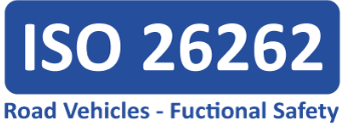
Functional Safety
ISO 26262 is intended to be applied to safety-related systems that include one or more electrical and/or electronic (E/E) systems and that are installed in series production passenger cars with a maximum gross vehicle mass up to 3500 kg. ISO 26262 does not address unique E/E systems in special purpose vehicles such as vehicles designed for drivers with disabilities.
ISO 26262 addresses possible hazards caused by malfunctioning behavior of E/E safety-related systems, including interaction of these systems. It does not address hazards related to electric shock, fire, smoke, heat, radiation, toxicity, flammability, reactivity, corrosion, release of energy and similar hazards, unless directly caused by malfunctioning behavior of E/E safety-related systems.
What Does ISO 26262 Require?
ISO 26262 is an electronic / software safety supplement to new product development processes. The standard details expectations and requirements to provide guidance for the following:
- Products. The standard requires a safety case and a number of confirmation measures to be applied during the product lifecycle.
- Processes. The standard requires specific life cycle processes to be implemented within a safety management system driven by a risk-based approach.
The word “safety” is subject to various interpretations. However, when applied to modern automobile design it can generally be categorized using the following structure:
Passive safety:
Assuming that an accident is effectively inevitable, the aim of passive safety mechanisms is to minimize the severity of that accident. The passive safety elements found within a vehicle include seatbelts, crumple zones, etc.Active safety:
The systems that are concerned with active safety (based on the knowledge of the current state of the vehicle) will aim to avoid accidents altogether in addition to the minimization of its effects if an accident occurs. Seatbelt pre-tensioning, airbag deployment, predictive emergency braking, anti-lock braking systems and traction control are all examples of this.Functional safety:
This focuses on ensuring that all the electrical and electronic systems (such as power supplies, sensors, communication networks, actuators, etc), including (but not limited to) all active safety related systems, function correctly. Functional safety is dealt with by the ISO-26262 standard (published in November 2011).
Our Support:
- ISO 26262 safety standards and processes training.
- Consulting support to facilitate process definition, process training, process implementation on selected improvement projects according to functional safety based on ISO 26262 requirements.
- Preparation of safety case document.
- Preparation of Hazard and risk analysis.
- Pre-audit support.
WHY CHOOSE PROLAB Technologies?
There are various features to think about like our dedication to meet deadline, Low risk delivery model, High technology expertise ,World class team of highly experienced Lead Assessors and Consultants , know-how, ethnicity Compatibility, Modernized Processes, Reporting facilitate you to create prolonging returns for your business through consulting approach.

